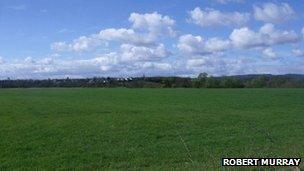Stirling academic to map Bannockburn battle site as it was
- Published

The project will focus on the Carse of Stirling, where the English army is thought to have camped in 1314
A University of Stirling academic is to carry out the first environmental reconstruction of the Battle of Bannockburn site as it looked in 1314.
Dr Richard Tipping's team will research the topography of the Carse of Stirling in an attempt to recreate the surroundings of the famous battle.
The researchers have been given £120,000 by the Leverhulme Trust to carry out the work.
The study is expected to be finished by the end of August.
Mapping the site will help historians to better understand what happened, and why, during the clash between the two armies 700 years ago.
Improved information
Dr Tipping said: "The terrain and ground conditions of the battle remain unknown.
"We judge Edward II's tactics on the battlefield by what we know of the topography now, but we may have done him a disservice.
"By recreating the landscape, we will assist historians to determine the ground conditions which he faced."
This is the first time carbon dating will be used to map the battle site as it was in the 14th century.
Dr Tipping added: "No-one has been able to do this before, but improvements in radio carbon dating mean that we will be able to date ground conditions to within a decade.
"We will be using scientific techniques to solve a historical problem; the story of the battle now is to explain the landscape, which plays a more important role than in most battles.
"All sorts of environmental issues affected the battle; for example, how many trees were there, where were they positioned and was Robert the Bruce hiding among them? The terrain was crucial to Edward's cavalry; was it peaty, a bog or well cultivated and drained farming land?"
Reviewing tactics
The research will focus on the Carse of Stirling because that is where the English army was positioned and it is assumed that the decisive second day of the battle was fought there.
Edward II's troops are thought to have camped somewhere on the Carse to the south east of Stirling Castle, a level plain imagined to have consisted of peat bog and sticky clay.
The decision to camp there has been seen as a major error on the part of the English King, as it would have hampered his cavalry, but it is not actually known what the Carse looked like in 1314.
The research will be used by the National Trust for Scotland to recreate the battlefield in a new visitor centre to be opened for the 700th anniversary celebration of the famous battle.
- Published10 December 2012
- Published26 November 2012
- Published31 October 2012
- Published31 October 2012
- Published26 October 2012
- Published12 October 2012
- Published2 October 2012
- Published18 September 2012